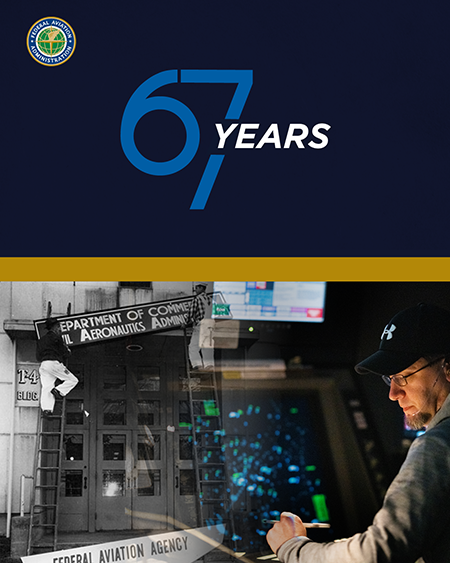Recognizing 67 Years of Advancing Aviation Safety

“A fully adequate and lasting solution to the Nation’s air traffic management problems will require a unified approach to the control of aircraft in flight and the utilization of airspace.”
In this June 13, 1958 message to Congress, President Dwight Eisenhower called for swift passage of legislation establishing a Federal Aviation Agency (later changed to the Federal Aviation Administration). The purpose was to safely bring our aviation system into the jet age by consolidating aviation authorities and developing and modernizing the national system of navigation and air traffic control facilities.
The need was urgent following a series of midair collisions. The first, on June 30, 1956, involved two passenger airlines over the Grand Canyon, killing all 128 people on both aircraft. Two more midair collisions between civil and military aircraft occurred in the spring of 1958.
Congress did indeed move with dispatch, passing a bill sponsored by Oklahoma Senator A.S. “Mike” Monroney in whose honor the FAA’s aeronautical center in Oklahoma City is named. Eisenhower signed the bill into law on Aug. 23, 1958.
The FAA began operations on Dec. 31, 1958, with retired Air Force General Elwood “Pete” Quesada serving as Administrator. The agency’s charge was to provide for civil and military operations’ safe and efficient use of the national airspace and to regulate and promote civil aviation safety.
In the ensuing 67 years, from jet age to the emerging age of drones, commercial space operations, air taxis and renewed supersonic passenger flight, the FAA has remained steadfast in its mission to provide the world’s safest, most efficient aerospace system. Upon assuming his position as the FAA’s 20th administrator, Bryan Bedford said that he is “truly grateful for the opportunity to join this team and to lead an agency with such a critical mission.” Pointing to the FAA’s future, Beford said, “We’re building a modern, resilient, agile FAA—one that can meet today’s challenges and tomorrow’s demands. That means embracing innovation, staying ahead of emerging technologies like advanced air mobility, and making smart, forward-thinking investments in our systems and people.”
Through the years working diligently with industry and other stakeholders, the FAA has enabled major aviation safety improvements and innovative uses of the national airspace system. Among these significant achievements are:
- First airport surface detection equipment (ASDE-2) (1960)
- First Doppler VOR system (1961)
- Rule requiring cockpit voice recorders (1964)
- 90-second evacuation rule (1967)
- Requirement for safety belt use during takeoffs and landings (1971)
- First operational automated radar terminal system (ARTS) III at Chicago’s terminal radar control facility (1971)
- Low level wind shear alert system (LLWAS) becomes operational at seven major airports (1978)
- Mandate for fire-resistant seat cushions and emergency escape path markings (1984)
- Requirement for passenger airlines to carry large emergency medical kits, in addition to basic first aid kits (1986)
- First type certificate for an all-composite aircraft (1988)
- First operational automated weather observing system (AWOS) (1989)
- First U.S. licensed commercial space industry launch (1989)
- FAA approves use of Global Positioning System (GPS) satellites for non-precision airport approaches (1993)
- First aircraft equipped with advanced terrain awareness warning systems (1997)
- Commercial Aviation Safety Team (CAST) formed to adopt a proactive focus on detecting risk and implementing mitigation strategies before accidents or serious incidents occur (1997)
- Upgraded flammability standards for materials in transport-category airplanes (2003)
- First airworthiness certificate for a civil unmanned aerial vehicle (2005)
- Automatic Dependent Surveillance Broadcast (ADS-B) system first used by air traffic controllers (2009)
- U.S. commercial airlines required to develop Safety Management Systems (2015)
- Authorized commercial drone flights without visual observers (2024)
- Powered-Lift rule defining the qualifications and training that instructors and pilots must have to fly air taxis (2024)
- New FAA MOSAIC rule issued to increase the availability of safe, modern, and affordable aircraft for recreational aviation, flight training and certain aerial work (2025)
A constant throughout the FAA’s history has been our workforce’s commitment to always learn from the past as we develop new safety regulations and technologies. The FAA, alongside the aviation industry and stakeholders, will continue to give the highest priority to the safety of the national airspace system and explore the possibilities of aviation’s future for years to come.
